Scorpion EXO-1000 Helmet Review
In light of today's rocketing retail prices on almost everything from fuel to your favorite bottle of distilled potato juice, it sure is nice to find a bargain now and again. Especially when that bargain is on something you need. So get those economic stimulus payments primed, because you need a new helmet!
Scorpion, or more correctly Scorpion Sports, hasn't been on the lid scene very long relative to helmet giants like Arai, Shoei, AGV or the re-surging Bell, but in a short time Scorpion has come on strong. So strong that they've now expanded beyond just helmets, adding a line of riding gear to further bolster the brand. But however big Scorpion grows, it all goes back to the company's success with helmets that offer a lot quality at a very reasonable price point, and it seems the lid maker hasn't forgotten its roots. Enter the Scorpion EXO-1000.
Introduced over a year ago, the latest brain bucket to join the EXO (pronounced ex-oh, like exoskeleton) full-face street line, the EXO-1000 is the slickest and trickest yet from the young American-led company. It employs all of the best features available on the other models, like KwikWick water/perspiration-absorbing and wicking material that makes up the removable liner; EverClear anti-fogging faceshield; and SpeedShift, Scorpion's tool-less faceshield removal system. Along with those very useful items that we already enjoyed on other EXO models, the 1000 ups the ante and incorporates new technology like SpeedView, the in-helmet retractable sunvisor lens, and –this is the big one!– inflatable air bladders situated behind the cheek pads called HelmetPump. The idea with HelmetPump is to allow a wearer to "customize" helmet fit.
I initially was skeptical of a motorcycle helmet – something specifically engineered to prevent head injuries – that uses '80s Reebok-style shoe-pump technology. Even though it seems a little gimmicky, HelmetPump does work as advertised. Once you've pulled the helmet over your melon and secured it via a typical strap and D-ring, simply poke a finger inside to the lower part of the chinbar and start pressing on the little red inflater. Within the first pump you'll hear the bladders start to fill with air, and depending on how the helmet fits before inflating, by the third or fourth pump you really start to feel the cheek pads move in, snugging up against your face. For my face to get a good squeeze while still being comfortable took somewhere between 17 to 20 pumps.
Many would rightly contest that a rider should just buy a helmet that fits properly from the beginning. But there's something to be said for relaxing the fit for a few moments, say, when you're off the bike without actually having to take the helmet off. Ready to ride again? Start pumping and you're back to that same cozy feeling you had before you used the little deflater button next to the pump to bleed all the air in the blink of an eye.
I wear a medium in Scorpion's EXO-400. Like most price-point lids, the 400 had a roomier fit – mostly from soft pad foam – than what you'd expect from a more costly helmet. Oddly, with the size medium 1000, the first sensation experienced as I pulled it over my head was that it was going to be a tight squeeze, but, once on, the fit seemed even roomier than the 400. Riders like me that have a hard time with many Asian head-form helmets will probably appreciate the overall feel if you're not too concerned with a super-snug fit for that ultra-safe feeling
The other new feature is the flip-down internal visor; what I would consider more like a half shield. When retracted into its space in the outer fiberglass/Kevlar shell, it's nearly impossible to tell the SpeedView is there. With one quick and smooth flip of a tiny lever mounted inconspicuously behind the faceshield left-side pivot gear, the SpeedView slides down and up easily. This type of secondary visor is appearing more frequently on other brands, and it's easy to see why. It does a good job of protecting the rider from that dangerous time just before dusk as the sun sinks to the horizon, potentially temporarily blinding a rider. When it gets too dark for tinted lenses, just flick the SpeedView up and you're back to the clear lens. I prefer to use tinted lenses on all my helmets, but I can certainly see how you get two lenses for the price of one with SpeedView.
The 1000 has a pretty robust ventilation system. There's a brow vent, a chinbar vent and two smaller vents on the top of the helmet, each operated separately. The system also has a series of exhaust vents or holes, two on each side near the front, and two at the back. Also, there is an exhaust vent in the back near the top that can be opened or closed. Though all the vents that can be opened are cleanly integrated into the look and design of the helmet and have positive, reassuring-sounding clicks when closing, I can't say that venting is incredibly effective. And the chinbar vent opens outward rather than just sliding out of the way like the brow vent. The chinbar vent seems like it doesn't allow much more air in when it's open than when it's closed.
We've had some pretty warm days here in SoCal already, giving me ample opportunity to test ventilation. Whether or not air is actually moving through I can't say because I can't see it, but I can say that it doesn't feel like much cooling is taking place. Perhaps an unexpected benefit is that the 1000 is a quiet helmet. I've had those pricey buckets before and a few of 'em are LOUD.
Lastly, something that seems to plague price-point lids is weight, and the 1000 is a rather hefty unit. Published figures have it coming in around 4 pounds. No doubt the extra gadgetry of the HelmetPump and SpeedView contribute to the weight, as well as the larger shell that's needed to accommodate those two features. On the up side, the 1000 has a couple of little items that are useful, like the removable wind curtain under the chin, breath deflector, a snap to secure the loose end of the chin strap, and a little lever on the left side of the faceshield that can prop the left side open a skosh for additional venting or to lock the shield shut. Perhaps the small opening created by this little lever wouldn't be necessary if the shield pivot gear had more than just four positions, allowing the lens to open in smaller increments rather than almost half way open on the first detent.
Paint and graphics quality are top notch, making the helmet look much more expensive than it is. As a matter of fact, much about the Scorpion EXO-1000 looks and functions like a more costly helmet.
Time will tell if riders will embrace the "pump" as something more than trendy or gimmicky. It isn't a cheap, flimsy item, but some might opine that a helmet that fits properly in the first place may offer more reliable safety benefits.And if the helmet's non-inflated fit is loose, a leaky air bladder (for whatever reason) would render the helmet unusable. Pump aside, the 1000 like most of Scorpion's helmets, has a quality that belies its MSRP. The graphic version you see here, called the Apollo, comes in four colors and retails for $349.95; solids range from $319.95 to $329.95. All have both DOT and Snell certification.
In this day of escalating costs, the EX0-1000 is an attractive bargain indeed.
Related Reading
Spring Helmet Bazaar
More by Pete Brissette




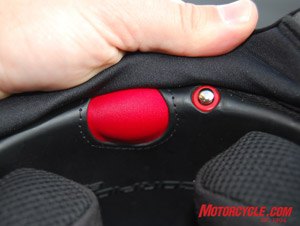










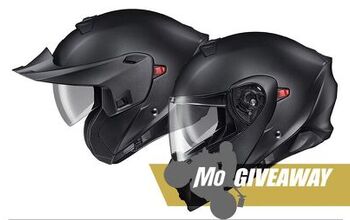






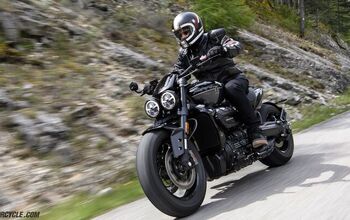



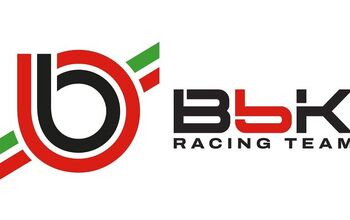
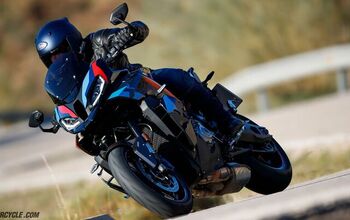




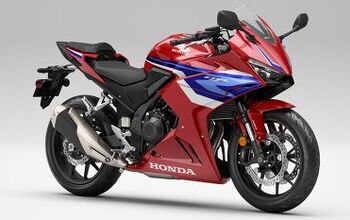
Comments
Join the conversation